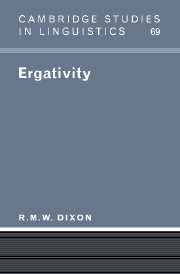Book contents
- Frontmatter
- Contents
- Preface
- Acknowledgements
- Appeal
- List of abbreviations
- 1 Introduction
- 2 Syntactically based and semantically based marking
- 3 Intra-clausal or morphological ergativity
- 4 Types of split system
- 5 The category of ‘subject’
- 6 Inter-clausal or syntactic ergativity
- 7 Language change
- 8 The rationale for ergativity
- Appendix: A note on theoretical models
- References
- Index of authors
- Index of languages and language families
- Subject index
2 - Syntactically based and semantically based marking
Published online by Cambridge University Press: 06 July 2010
- Frontmatter
- Contents
- Preface
- Acknowledgements
- Appeal
- List of abbreviations
- 1 Introduction
- 2 Syntactically based and semantically based marking
- 3 Intra-clausal or morphological ergativity
- 4 Types of split system
- 5 The category of ‘subject’
- 6 Inter-clausal or syntactic ergativity
- 7 Language change
- 8 The rationale for ergativity
- Appendix: A note on theoretical models
- References
- Index of authors
- Index of languages and language families
- Subject index
Summary
Before venturing into a detailed examination of kinds of ergative and accusative grammatical patterning, we must distinguish between two different kinds of strategy that languages employ for marking ‘who is doing what to who’. These can be called (1) the syntactically based (or ‘prototypical’) alternative, and (2) the semantically based (or ‘direct’) alternative. We shall see that labels such as nominative, accusative, absolutive and ergative are only properly applicable to languages of the first type.
For languages of the first type, each verb has a prototypical meaning, and grammatical marking is applied to the verb's arguments on the basis of their function in the prototypical instance. English basically follows this approach. The prototypical meaning of hit is that in He hit me (implied: with his hand) or He hit me with a stick. The agent (who propels the implement) is marked as transitive subject (A), being placed before the verb (and being in nominative case if a pronoun). The target, which the implement comes into contact with, is marked as transitive object (O), and placed after the verb (being in oblique form if a pronoun).
When the verb is used with a non-prototypical meaning the same grammatical marking of arguments applies. Hit is categorised as a transitive verb and so there must be a transitive subject stated. In The falling branch hit me, the noun phrase the falling branch is treated as being in A function, although it is not an agent propelling an implement (nor an implement propelled by an agent).
- Type
- Chapter
- Information
- Ergativity , pp. 23 - 38Publisher: Cambridge University PressPrint publication year: 1994



